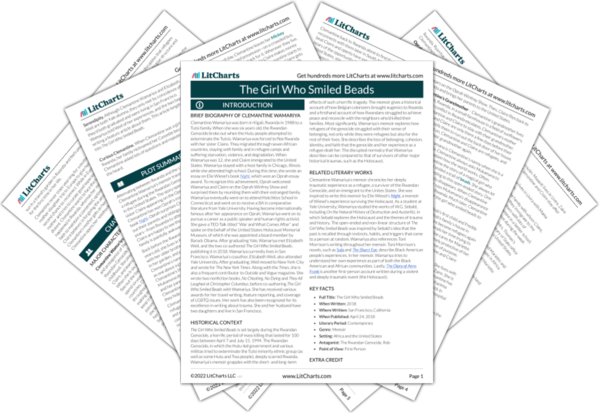Set largely during the Rwandan Genocide, The Girl Who Smiled Beads depicts a trauma that tragically altered the way people conceive of the world. Clemantine is six years old when the Rwanda Genocide breaks out and she suddenly becomes a refugee. At such a young age, the horrors she witnesses—hunger, degrading comments, bombs exploding, dead bodies floating in a river—seem to her like illogical, evil acts that she can’t wrap her head around. When Clemantine later learns the complete history of the Rwanda Genocide from a textbook, it is no more logical than was her experience of it as a young girl. She cannot comprehend the idea that a group of human beings could kill another group of human beings—it is categorically wrong. The Rwandan Genocide—both her firsthand experience and secondhand knowledge of it—ruins Clemantine’s faith. Not only does she no longer believe in God as she once did, but she can barely find cause to view the world as a kind, just, and peaceful place. In this way, the memoir shows how trauma can fundamentally change people’s beliefs and worldviews, even long after the traumatic event occurred.
Although some survivors of the genocide maintain their faith in various ways, these outlooks now seem naïve and irrational to Clemantine. For instance, when she visits Rwanda after the genocide has ended, she is appalled that, to achieve peace, Rwandan citizens are uniting with the very neighbors who killed and raped their families as if nothing happened. Along these lines, Clemantine’s sister Claire maintains that people should forgive the crimes of the genocide aggressors so as to achieve their own personal peace. Clemantine strongly disagrees, believing that it is impossible to ask people to forgive when they’ve experienced such fundamental wrongs. Similarly, Clemantine opposes her mother’s stubborn religious outlook that refuses to question why such bad things happened in a good world. In this way, the Rwandan Genocide disrupts Clemantine’s conceptions of the world so radically that her ability to forgive and her faith in the world are permanently compromised.
Trauma and Faith ThemeTracker

Trauma and Faith Quotes in The Girl Who Smiled Beads
I now felt I’d made a mistake in Uvira. I’d let my guard down. I’d allowed myself to feel I belonged. But there was no real belonging—not anymore. There was only coming and going and coming and going and dying. There was no point in letting anybody get close.

Unlock explanations and citation info for this and every other The Girl Who Smiled Beads quote.
Plus so much more...
Get LitCharts A+I resent and revile [the word genocide]. The word is tidy and efficient. It holds no true emotion. It is impersonal when it needs to be intimate, cool and sterile when it needs to be gruesome. The word is hollow, true but disingenuous, a performance, the worst kind of lie.
I wanted to piece [the] world back together, but the idea of one group of people killing another group of people—people they lived with, people they knew—that chunk of knowledge could never fit itself in my mind. It was categorically, dimensionally, fundamentally wrong. It was like trying to store a tornado in a chest of drawers. That was not how the universe worked.
To be a refugee was to be a victim—it was tautological. And not just a victim due to external forces like politics or war. You were a victim due to some inherent, irrevocable weakness in you. You were a victim because you were less worthy, less good, and less strong than all the non-victims of the world.
It felt surreal and awful. I’d lost track of who I was and who we were to each other. None of us were the same people who’d lived together in that house in Kigali. Those people had died. We had all died.
I understand that forgiveness is utilitarian, that it is likely even the missing piece in my life, the keystone that will allow me to balance and stabilize and keep the bricks of my life from tumbling down. But I can’t do it. To me it feels false.
The plot provided by the universe was filled with starvation, war, and rape. I would not—could not—live in that tale.
Instead, I would be the girl who smiled beads, my version of the girl who smiled beads, one who had power and agency over her life, one who did not get caught.
I need more than the artifacts stuffed into a suitcase. I need to comprehend my history, a deep history. I know the facts about the genocide […] But that is not enough. The past, that story, cannot fill me. I need a longer, broader, more fully human backstory, a history not all soaked in blood. I need clarity, perspective, joy, beauty, originality, intelligence, a wide-angle view.
[Rwandans] needed to find a way to tolerate an intolerable truth. We needed to acknowledge facts that are incompatible with a stable faith in humanity, incompatible even with any sane definition of God.
Insist on knowing the backstory to your gifts and your pain. Ask yourself how you came to have all the things you carry; your privilege, your philosophy, your nightmares, your faith, your sense of order and peace in the world.











